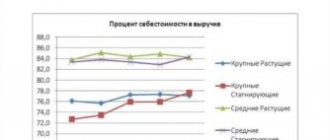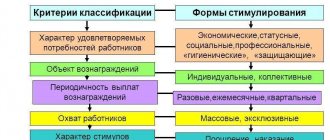What is KTU in wages
The abbreviation KTU stands for “labor participation rate”.
It allows you to fairly distribute a certain amount of money earned by the whole team among individual participants. KTU is used when calculating remuneration that is intended for a group of people. Classic examples: bonus to the crew upon completion of work; bonus to the department upon completion of the project, etc. If we are talking about remuneration that is accrued to only one employee, it makes no sense to use the labor participation coefficient.
Calculate your salary and benefits taking into account the increase in the minimum wage from 2020 Calculate for free
Who installs? Distribution of funds
Labor legislation does not regulate clear positions regarding the calculation of earnings according to the labor participation rate (KTU). The calculation is made in a convenient way, the main thing is that there are no contradictions with laws and other regulatory documents.
It is important to know that no matter how earnings are distributed, the amount that each member of the work team receives cannot be less than what is due according to the tariff for similar work performed in a specific period of time.
Depending on the form of payment, the coefficient is applied in:
- Tariff-free system. The amount to be paid is divided by the number of employees, and then the average coefficient, equal to one, must be adjusted based on the KTU.
- Distribution in excess of the tariff. Each employee receives a fixed amount of money according to the tariffs, and the rest of the money must be divided taking into account the coefficient.
When KTU cannot be used
The Labor Code does not contain the concept of “KTU”. However, this tool is legal if certain restrictions are met.
IMPORTANT. It is unacceptable that the use of the coefficient leads to a reduction in the wages stipulated in the employment contract. Let's explain with an example. Let’s say an employee worked the required time and complied with labor discipline. However, his contribution to the common cause was minimal, and he was assigned the lowest KTU value in the department. The management has the right to reduce his bonus, but does not have the right to reduce his salary.
There are payments guaranteed by law, the amount of which cannot depend on the labor participation rate. These include, in particular:
- extra pay for night shift;
- overtime;
- additional amounts for working on weekends and holidays;
- additional payment for hazardous working conditions;
- sickness benefits, maternity benefits, etc.
Create a staffing schedule for free using a ready-made template
Features of application
This indicator shows the overall qualitative and quantitative assessment of the work of employees, specialists and management in an overall positive result, that is, in the intensity and productivity of work.
In the basic value, KTU is expressed as one whole unit or 100%. This contributes to the calculation of the average assessment of employee performance and relates directly to those employees of the general team who fulfilled the production plan for the reporting period, had no recorded violations of labor protection rules, and were not involved in disciplinary punishments.
The basic labor participation rate has the ability to decrease and increase depending on the indicators that influence it. Indicators reflect the contribution of one employee to the overall collective result.
This coefficient can be calculated based on the results of a monthly period. Indicators that have an impact on the KTU are taken into account daily for a complete and high-quality calculation.
The additional payment for participation is applied to remuneration for work activities when distributing team additional income, bonuses and remunerations that are assigned to a specific area, workshop or team.
The tariff is calculated based on the salary and time actually worked by the team, despite the labor participation coefficient established for the employee.
The following are not collective income and, accordingly, are not distributed with the help of the CTU:
- Additional payments for night work, harmful and difficult working conditions, overtime and management of a team or unit.
- Allowances for qualifications and work experience.
- Rewards related to inventions.
- Disability benefits or any other type of individual benefits.
At established tariffs
The labor participation coefficient can be used not only in non-tariff wage rates, but also taking into account the tariff salary. KTU can be used to divide the wage fund into parts. Additional payments that may be included in the calculation of the indicator at established tariffs:
- bonus for exceeding the plan by the team;
- saving money related to the wage fund;
- one-time benefit when revaluing temporary standards.
According to the accruals that are made taking into account the tariff, the part of the funds that is subject to payments to the KTU is deducted from the earnings of the team’s employees.
Distribution of funds
Based on the way in which the form of remuneration, both individual and collective, is laid down in the enterprise’s Charter, as well as on the orders of the immediate supervisor, the use of the indicator of collective labor participation looks like this:
- Tariff-free earnings accrual system. In this case, the total amount earned by the entire team is distributed by calculating the average income for each employee, then the resulting result is adjusted using the labor participation indicator.
- Remuneration made in excess of established standards. Each of the employees of the team receives a salary depending on the tariff distribution rate, and the funds that are on the balance are transferred to the employees’ accounts taking into account the coefficient.
Where not to use
The indicator of distribution of funds from labor participation is applicable only in the case when labor activity is carried out collectively. According to the Regulations for the application of this coefficient, it is applied only in the area that is regulated. The participation fee does not include:
- Compensation to an employee for harmful working conditions.
- Cash surcharges above the norm.
- Additional payments for going to work on weekends and non-working holidays, at night and in the evening.
- Type of cash benefits.
Who installs
The Labor Code does not establish a procedure for calculating wages taking into account the participation rate; it is independently determined by the enterprise staff. The procedure for calculating such funds may differ depending on working conditions and the type of industry, but in no way should contradict the regulatory framework.
Earnings are distributed in a variety of ways, but it should be remembered that funds in the form of wages for each employee cannot be less than the established tariff rate (salary).
How to calculate the labor participation rate
There is no universal formula. Therefore, an organization can develop its own algorithm and enshrine it in local regulations (regulations on bonuses, collective agreement, etc.).
In practice, the following scheme is most often followed. Each employee is awarded a personal score, which characterizes his participation in the production process. Next, they take the amount of collective remuneration and distribute it among employees in proportion to their points.
What is a personal score? This is KTU. As a rule, it consists of two parts.
- Base part (always equal to 1).
- Demotion or promotion (composed of ratings for given factors).
REFERENCE. If, in the opinion of management, all employees have made an equal contribution to the common cause, then there will be no demotions or promotions. In this case, the score of each employee is 1. Then the bonus amount is divided equally among all participants, and everyone receives the same shares.
Group (collective) wages
Group wage systems, reflecting the concerted efforts of a group of a work team, a structural unit, or an organization as a whole, rather than an individual worker. The most commonly used are mixed salary systems, where one part of the employee’s remuneration, usually a permanent salary, depends on his individual characteristics, and the other, usually a variable one, depends on the results of the group’s work. With direct team piecework wages, wages are paid not to an individual performer of the work, but to the team at a single piece rate for the entire volume of high-quality work performed, and then earnings are distributed among team members in proportion to the level of the tariff rate and the actual time worked by each team member. Collective team piecework wages are used for assembly, repair and installation of large units, operation of railway rolling stock, in the mining industries, etc. Team piecework wages can be used in cases where the labor of workers is functionally divided, i.e. Time production standards in this case, groups of workers are established not for each worker, but for the entire team.
This is important to know: Pay for salaries on holidays
The piecework wage system is used when it is possible to take into account quantitative indicators of the result of labor and normalize it by establishing production standards, time standards, and standardized production tasks. Labor standards - production standards, time, service, number - are established for workers in accordance with the achieved level of equipment, technology, organization of production and labor. Under the piecework system, workers are paid at piecework rates in accordance with the quantity of products produced, work performed and services rendered. According to the article of the Labor Code of the Russian Federation, when an employee with piecework wages performs work of various qualifications, his work is paid according to the rates of the work he performs. With piecework wages, prices are determined based on established grades of work, salary rates and time standards.
Direct piecework and indirect piecework payment systems
With a non-tariff wage system, wages are determined as the employee’s share in the payroll fund. In modern conditions, three forms of remuneration can be distinguished: piecework, time-based and mixed. Piecework wages - payment in accordance with the quantity of products produced. Its types:. Under the direct piece-rate wage system, labor is paid at rates per unit of output. Under an indirect piecework system, the size of a worker’s earnings is directly dependent on the results of the labor of the workers he serves. Rk-sd - indirect piece rate rate of the serviced worker, paid according to the indirect piece rate system, rub.
WATCH THE VIDEO ON THE TOPIC: Time-based form of remuneration - Payroll calculation
PIECE WAGE SYSTEMS
In modern production, collective forms of organization and remuneration are often used, which is determined both by the technological maintenance of large units, automated lines or the organizational need for a group of workers to jointly perform a complete set of interrelated works, as well as by the desire to materially interest workers in the results of collective activity. In domestic practice, the most common form of collective group organization of labor is production teams. In this regard, the concepts of collective and team payment are often used interchangeably. The most widespread is the collective brigade piecework wage system. Its use requires compliance with the following conditions:. With this payment system, the total piecework earnings of the team of the ZBR brigade is determined as the sum of the products of the brigade prices P i for individual types of production work by the volume of work performed by the brigade, the quantity of manufactured products in the accepted planning accounting units O i:. Methods for determining brigade prices depend on the content and nature of the work performed, methods of their rationing and accounting. When performing assembly, installation, and repair work, consisting of operations of varying complexity, the brigade piece rate per unit of work can be calculated using the formula: If the production of final products involves the performance of a number of works for which independent prices are established, the complex team price per unit of final product is calculated as follows:
Payroll accounting in construction
Electronic signature in 1 hour for: trading. A simple piece-rate system involves payment for the quantity of products produced and the volume of work or services performed based on the piece-rate rates accepted by the company. Such prices are determined per unit of product of one type or another. The piece rate is RUB. The company's worker Ivanov produced finished products in the following quantities: Piece prices may vary and increase or decrease depending on the quality of the products produced.
When servicing the unit by a group of workers with different placement qualifications, a comprehensive piece rate is determined by the formula. N exp is the production rate per unit for the same period for which the vehicle is taken into account.
Reducing factors
Their list is approved by the company’s management based on the specifics of the business process. Each factor has a corresponding score. This is a constant value, the same for all employees without exception (see Table 1).
Table 1
An example of a list of reducing factors in a trade organization
| No. | Reducing factor | Grade |
| 1 | Late for work | 0,3 |
| 2 | Absenteeism without good reason | 0,9 |
| 3 | Negative feedback from a client | 0,6 |
| 4 | Late submission of primary documents to the accounting department | 0,2 |
ATTENTION. When calculating an employee’s personal score, scores obtained from reducing factors are taken with a minus sign. So, if a person received 0.3 for being late for work, the calculations will be as follows: 0.3 is subtracted from the basic KTU. The result will be a score of 0.7 (1 - 0.3).
Increasing factors
Their list also directly depends on the specifics of the company or its division. For a workshop that produces furniture there will be one list, for the transportation department there will be another, etc. The company's management must develop and approve a list of criteria in advance, assigning a rating to each of them (see Table 2).
table 2
An example of a list of increasing factors in a trade organization
| No. | Boosting factor | Grade |
| 1 | Concluding agreements with new customers | 0,8 |
| 2 | Extension of previously concluded contracts with customers | 0,7 |
| 3 | Positive feedback from the client | 0,6 |
| 4 | Trainee training | 0,4 |
Compose HR documents using ready-made templates for free
The procedure for issuing KTU to collective workers
The monthly value of the KTU has the right to determine and approve the head of the team (team) or the general meeting of workers. It all depends on which of these options is fixed in local documents. In the first option, the head of the group (team, collective) or the personnel officer does the calculations on a monthly basis. BEFORE the CTU is approved by the manager, each participant in the collective work is familiarized with the set value of the multiplier.
At this point, in case of disagreement, the employee has the right to challenge the value of the KTU and express his claims. The second version of the calculation is carried out by the council of the brigade (department, etc.). It is within his competence to consider the need to apply increasing or decreasing criteria and calculating the final value of the KTU.
The results of the meeting are recorded in a protocol, which is signed by all participants and given to the employer for final approval of payments.
Example of KTU calculation (table)
The trading company has adopted a provision on bonuses. It specifies the increasing and decreasing criteria given above in Tables 1 and 2.
The staff has four employees: Ivanov, Petrov, Sidorov and Kuznetsov.
At the end of December, a bonus was awarded in the amount of 300,000 rubles, which must be distributed among employees. A statement for December was compiled, which reflects the assessments received by employees (see Table 3).
Table 3
KTU statement for December
| № p/p | Full name of the employee | KTU base part | Reducing factors | Increasing factors | KTU | ||||||
| 1 | 2 | 3 | 4 | 1 | |||||||
| 1 | Ivanov I.I. | 1 | -0,3 | 0,8 | 0,7 | 2,2 | |||||
| 2 | Petrov P.P. | 1 | -0,6 | 0,4 | |||||||
| 3 | Sidorov S.S. | 1 | -0,2 | 0,6 | 1,4 | ||||||
| 4 | Kuznetsov K.K. | 1 | -0,6 | 0,7 | 0,4 | 1,5 | |||||
| Total: | 5,5 | ||||||||||
We see that Ivanov received a deduction of 0.3 (lateness), as well as an increase: 0.8 (conclusion of new contracts) and 0.7 (extension of contracts). His personal score was 2.2 (1 - 0.3 + 0.8 + 07). The scores of other employees are calculated in a similar way.
All that remains is to distribute the prize:
- Ivanov 120,000 rub. (RUB 300,000 / 5.5 × 2.2);
- Petrov RUB 21,818 (RUB 300,000 / 5.5 × 0.4);
- Sidorov RUB 76,364 (RUB 300,000 / 5.5 × 1.4);
- Kuznetsov RUB 81,818 (RUB 300,000 / 5.5 × 1.5).
To check, we will find the amount of bonuses accrued to each employee. We will receive: 120,000 rubles. + 21,818 rub. + 76,364 rub. + 81,818 rub. = 300,000 rub.
Calculate “complex” salaries with coefficients and bonuses for a large number of employees
Criteria for increasing and decreasing the indicator
The indicator is established when the production tasks of the enterprise are fulfilled without violations of labor discipline and exactly on time by the manager.
There are several criteria for increasing and decreasing the coefficient.
Raising:
- The team takes the initiative to master advanced technologies and workplaces, which significantly reduces labor costs (+0.2 +0.4).
- Increasing the intensity and efficiency of the team to reduce the established deadlines for completing the task (+0.2 +0.4).
- An employee’s performance of complex procedures, initiative to combine several professions, or assistance in work activities to other employees of this team (+0.1 +0.3).
- Carrying out activities that do not correspond to the qualification level, but performing tasks that are an order of magnitude higher (+0.1 +.0.3).
Downgrades:
- The assigned task was not completed on time (-0.2 -0.4).
- Marriage in the process of work, which determines the possibility of high labor costs (-0.2 -0.4).
- Failure to complete the order (-0.1 -0.3).
- Violation of the rules of operation and operation of mechanized production and equipment (-0.2 -0.5).
- Damage or loss of working tools (-0.3 -0.5).
- Activities that do not comply with safety and health regulations (-0 -0.5).
- Disciplinary violations of the production regime (-0.2 -0.5).
- Missed workday (0).
- Disciplinary violation of the customer's rules (-0 -0.5).
Disadvantages and advantages of KTU
The main advantage of the method is its simplicity. Indeed, any specialist can do simple calculations without additional training. The employer gets the opportunity to implement a fair and transparent motivation system that does not require serious financial investments. The employee has complete information about why he was paid this particular amount and not another.
But there are also disadvantages. Unfortunately, not every production process allows us to draw up a clear list of adequate criteria for assessing the personal contribution of workers. But even if there is such a list, the so-called “human factor” plays a significant role in awarding the labor participation rate. Simply put, a manager can assign points not objectively, but based on personal preferences.
KTU criteria
There is no rule in the Labor Code of the Russian Federation that regulates the procedure for calculating the coefficient in question. This issue is left to the discretion of the employer. The algorithm for calculating KTU may be different. The main condition is that it does not contradict the law, in particular the Labor Code of the Russian Federation.
IMPORTANT: Regardless of the algorithm for distributing wages between members of the workforce, the amount received by each of them should not be less than what is due for similar work at certain rates.
The unit is the base value for KTU. Indicator 1 means that the employee, performing work with other team members, performed his duties in good faith and was able to comply with all established standards for time, quantity and quality characteristics. In this process, the employee did not make any mistakes, did not make mistakes, did not make any inaccuracies, and complied with all requirements for labor protection. During the calculation process, the resulting digital value may be in the range of 0. This means that the employee did not participate in the work of the team. The KTU criteria should be established as objectively as possible. For example, for each employee, their own criteria can be determined in the case of accounting for wages according to the KTU.
At the end of the working period, a special document (protocol) is used to calculate the KTU for each specific employee according to the established method. To calculate the CTU, certain parameters are used. Each of them is assigned a point. A specific person is assessed through each criterion, receives points, and they are summed up. To use the formula in calculating the KTU, you need to know the exact number of workers who took part in the distribution of wages at the specified tariff.
KTU = (O / O1 + O2 +…+ Оn) x N
Explanation of the formula:
KTU – labor participation coefficient; O – evaluation indicator assigned to each specific employee based on the sum of points; О1+О2+Оn is the sum of points for each specific employee; N – Number of members of the work team.










